Strategic Management: IKEA Case Analysis
VerifiedAdded on 2023/01/13
|16
|3504
|90
AI Summary
This essay provides a detailed analysis of IKEA's current and future prospects, including market and industry analysis, strategic recommendations, and SWOT and PESTLE analyses. It also discusses the competitive landscape and offers recommendations for the company's future success.
Contribute Materials
Your contribution can guide someone’s learning journey. Share your
documents today.
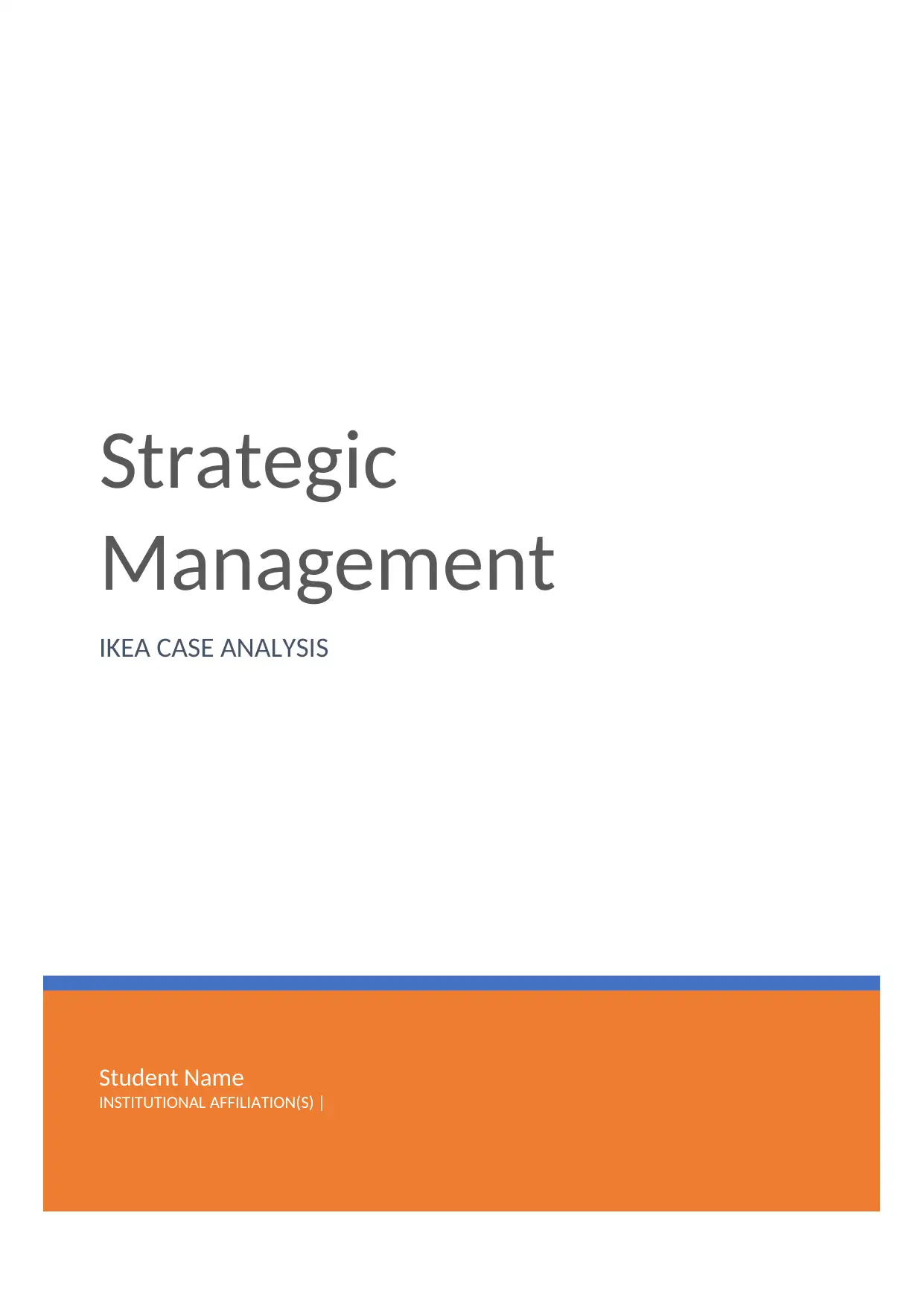
Student Name
INSTITUTIONAL AFFILIATION(S) |
Strategic
Management
IKEA CASE ANALYSIS
INSTITUTIONAL AFFILIATION(S) |
Strategic
Management
IKEA CASE ANALYSIS
Secure Best Marks with AI Grader
Need help grading? Try our AI Grader for instant feedback on your assignments.
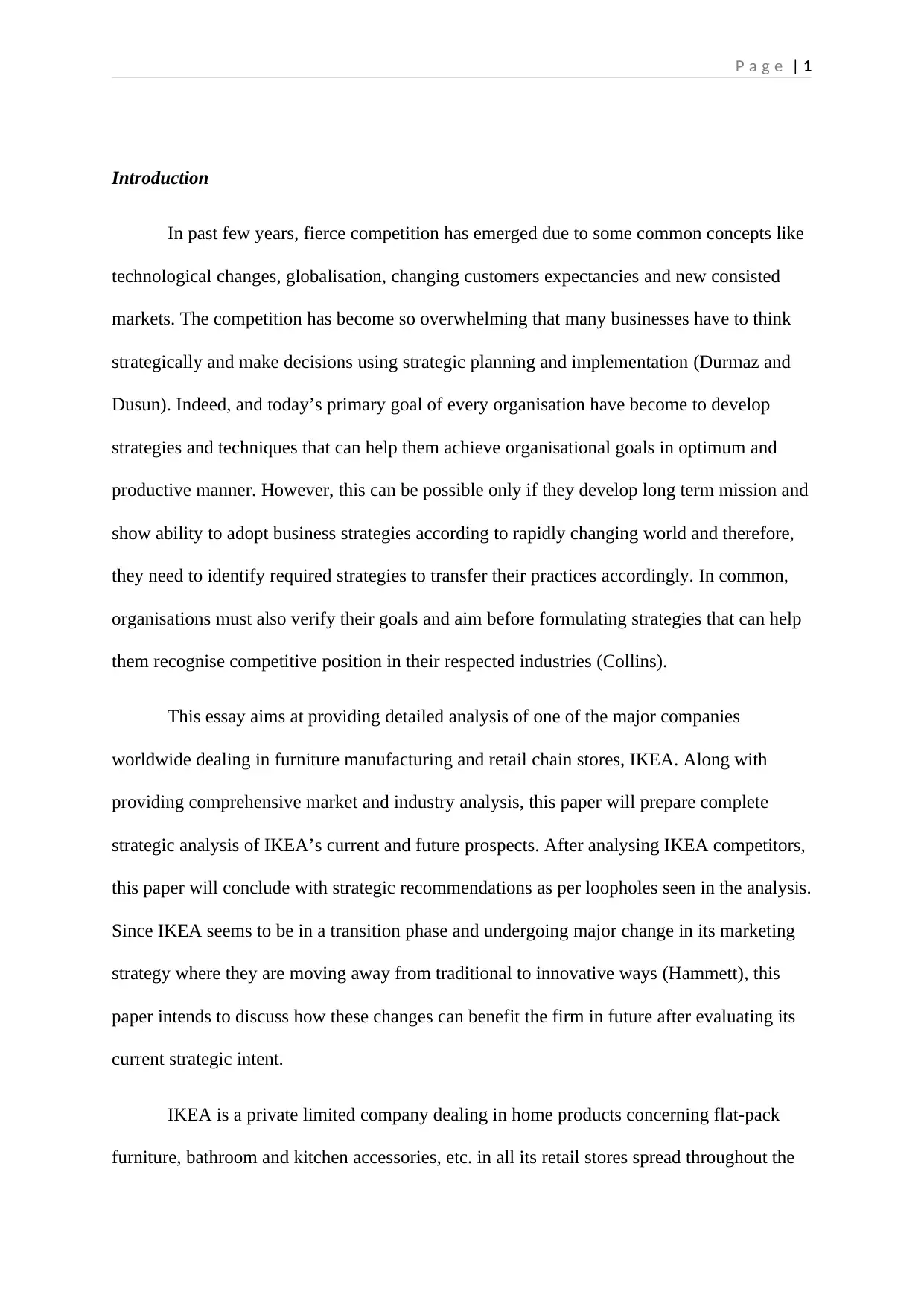
P a g e | 1
Introduction
In past few years, fierce competition has emerged due to some common concepts like
technological changes, globalisation, changing customers expectancies and new consisted
markets. The competition has become so overwhelming that many businesses have to think
strategically and make decisions using strategic planning and implementation (Durmaz and
Dusun). Indeed, and today’s primary goal of every organisation have become to develop
strategies and techniques that can help them achieve organisational goals in optimum and
productive manner. However, this can be possible only if they develop long term mission and
show ability to adopt business strategies according to rapidly changing world and therefore,
they need to identify required strategies to transfer their practices accordingly. In common,
organisations must also verify their goals and aim before formulating strategies that can help
them recognise competitive position in their respected industries (Collins).
This essay aims at providing detailed analysis of one of the major companies
worldwide dealing in furniture manufacturing and retail chain stores, IKEA. Along with
providing comprehensive market and industry analysis, this paper will prepare complete
strategic analysis of IKEA’s current and future prospects. After analysing IKEA competitors,
this paper will conclude with strategic recommendations as per loopholes seen in the analysis.
Since IKEA seems to be in a transition phase and undergoing major change in its marketing
strategy where they are moving away from traditional to innovative ways (Hammett), this
paper intends to discuss how these changes can benefit the firm in future after evaluating its
current strategic intent.
IKEA is a private limited company dealing in home products concerning flat-pack
furniture, bathroom and kitchen accessories, etc. in all its retail stores spread throughout the
Introduction
In past few years, fierce competition has emerged due to some common concepts like
technological changes, globalisation, changing customers expectancies and new consisted
markets. The competition has become so overwhelming that many businesses have to think
strategically and make decisions using strategic planning and implementation (Durmaz and
Dusun). Indeed, and today’s primary goal of every organisation have become to develop
strategies and techniques that can help them achieve organisational goals in optimum and
productive manner. However, this can be possible only if they develop long term mission and
show ability to adopt business strategies according to rapidly changing world and therefore,
they need to identify required strategies to transfer their practices accordingly. In common,
organisations must also verify their goals and aim before formulating strategies that can help
them recognise competitive position in their respected industries (Collins).
This essay aims at providing detailed analysis of one of the major companies
worldwide dealing in furniture manufacturing and retail chain stores, IKEA. Along with
providing comprehensive market and industry analysis, this paper will prepare complete
strategic analysis of IKEA’s current and future prospects. After analysing IKEA competitors,
this paper will conclude with strategic recommendations as per loopholes seen in the analysis.
Since IKEA seems to be in a transition phase and undergoing major change in its marketing
strategy where they are moving away from traditional to innovative ways (Hammett), this
paper intends to discuss how these changes can benefit the firm in future after evaluating its
current strategic intent.
IKEA is a private limited company dealing in home products concerning flat-pack
furniture, bathroom and kitchen accessories, etc. in all its retail stores spread throughout the
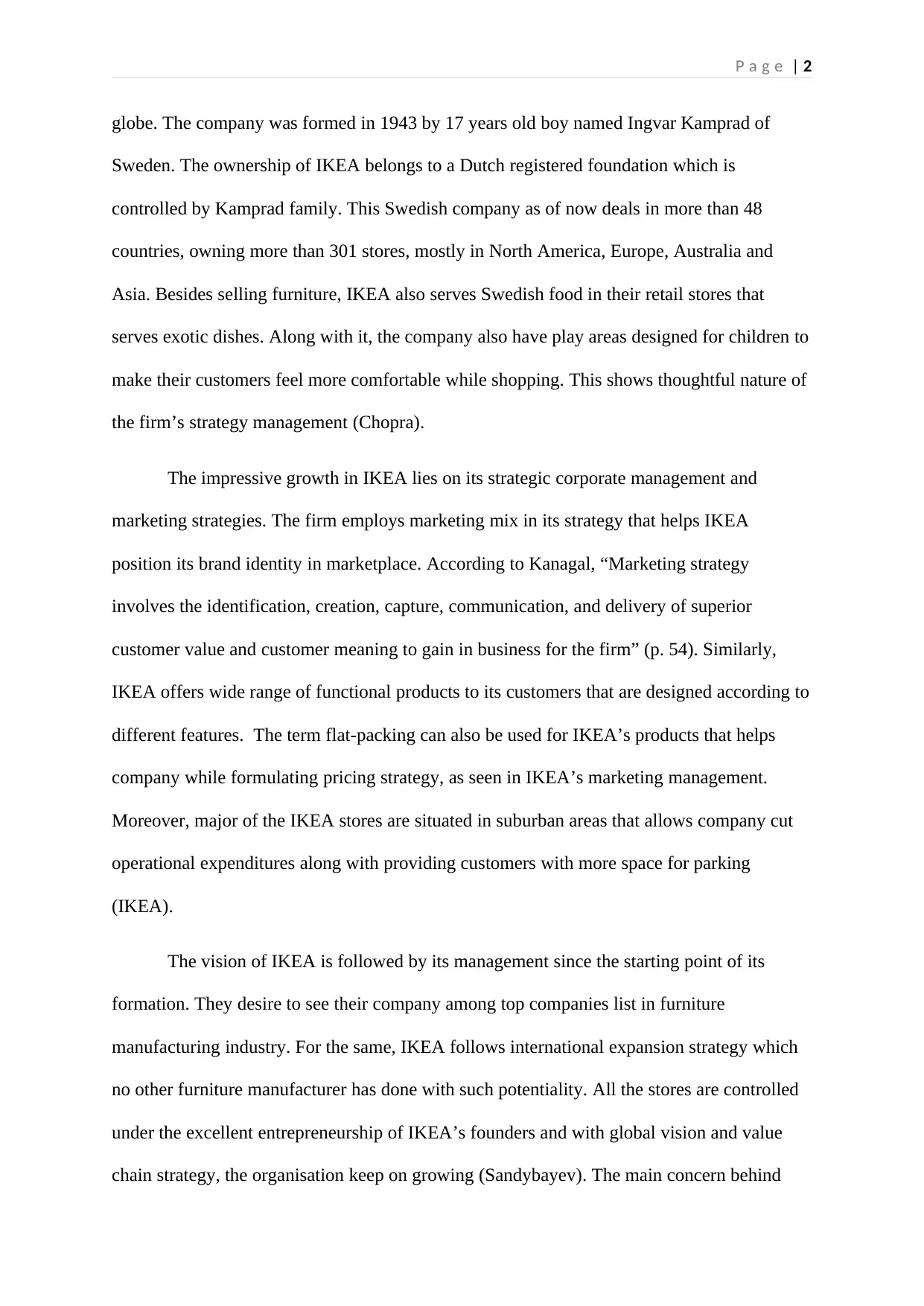
P a g e | 2
globe. The company was formed in 1943 by 17 years old boy named Ingvar Kamprad of
Sweden. The ownership of IKEA belongs to a Dutch registered foundation which is
controlled by Kamprad family. This Swedish company as of now deals in more than 48
countries, owning more than 301 stores, mostly in North America, Europe, Australia and
Asia. Besides selling furniture, IKEA also serves Swedish food in their retail stores that
serves exotic dishes. Along with it, the company also have play areas designed for children to
make their customers feel more comfortable while shopping. This shows thoughtful nature of
the firm’s strategy management (Chopra).
The impressive growth in IKEA lies on its strategic corporate management and
marketing strategies. The firm employs marketing mix in its strategy that helps IKEA
position its brand identity in marketplace. According to Kanagal, “Marketing strategy
involves the identification, creation, capture, communication, and delivery of superior
customer value and customer meaning to gain in business for the firm” (p. 54). Similarly,
IKEA offers wide range of functional products to its customers that are designed according to
different features. The term flat-packing can also be used for IKEA’s products that helps
company while formulating pricing strategy, as seen in IKEA’s marketing management.
Moreover, major of the IKEA stores are situated in suburban areas that allows company cut
operational expenditures along with providing customers with more space for parking
(IKEA).
The vision of IKEA is followed by its management since the starting point of its
formation. They desire to see their company among top companies list in furniture
manufacturing industry. For the same, IKEA follows international expansion strategy which
no other furniture manufacturer has done with such potentiality. All the stores are controlled
under the excellent entrepreneurship of IKEA’s founders and with global vision and value
chain strategy, the organisation keep on growing (Sandybayev). The main concern behind
globe. The company was formed in 1943 by 17 years old boy named Ingvar Kamprad of
Sweden. The ownership of IKEA belongs to a Dutch registered foundation which is
controlled by Kamprad family. This Swedish company as of now deals in more than 48
countries, owning more than 301 stores, mostly in North America, Europe, Australia and
Asia. Besides selling furniture, IKEA also serves Swedish food in their retail stores that
serves exotic dishes. Along with it, the company also have play areas designed for children to
make their customers feel more comfortable while shopping. This shows thoughtful nature of
the firm’s strategy management (Chopra).
The impressive growth in IKEA lies on its strategic corporate management and
marketing strategies. The firm employs marketing mix in its strategy that helps IKEA
position its brand identity in marketplace. According to Kanagal, “Marketing strategy
involves the identification, creation, capture, communication, and delivery of superior
customer value and customer meaning to gain in business for the firm” (p. 54). Similarly,
IKEA offers wide range of functional products to its customers that are designed according to
different features. The term flat-packing can also be used for IKEA’s products that helps
company while formulating pricing strategy, as seen in IKEA’s marketing management.
Moreover, major of the IKEA stores are situated in suburban areas that allows company cut
operational expenditures along with providing customers with more space for parking
(IKEA).
The vision of IKEA is followed by its management since the starting point of its
formation. They desire to see their company among top companies list in furniture
manufacturing industry. For the same, IKEA follows international expansion strategy which
no other furniture manufacturer has done with such potentiality. All the stores are controlled
under the excellent entrepreneurship of IKEA’s founders and with global vision and value
chain strategy, the organisation keep on growing (Sandybayev). The main concern behind
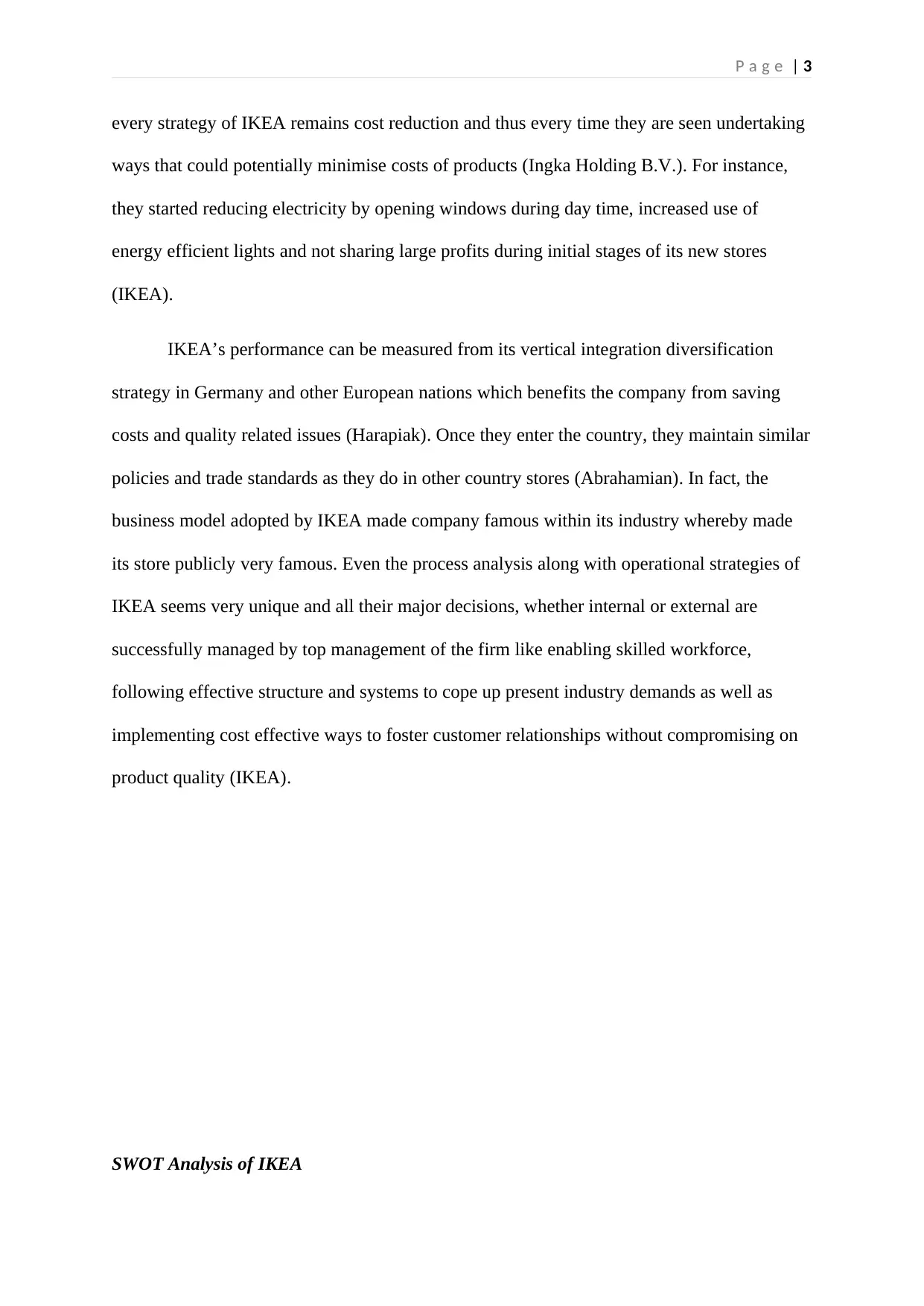
P a g e | 3
every strategy of IKEA remains cost reduction and thus every time they are seen undertaking
ways that could potentially minimise costs of products (Ingka Holding B.V.). For instance,
they started reducing electricity by opening windows during day time, increased use of
energy efficient lights and not sharing large profits during initial stages of its new stores
(IKEA).
IKEA’s performance can be measured from its vertical integration diversification
strategy in Germany and other European nations which benefits the company from saving
costs and quality related issues (Harapiak). Once they enter the country, they maintain similar
policies and trade standards as they do in other country stores (Abrahamian). In fact, the
business model adopted by IKEA made company famous within its industry whereby made
its store publicly very famous. Even the process analysis along with operational strategies of
IKEA seems very unique and all their major decisions, whether internal or external are
successfully managed by top management of the firm like enabling skilled workforce,
following effective structure and systems to cope up present industry demands as well as
implementing cost effective ways to foster customer relationships without compromising on
product quality (IKEA).
SWOT Analysis of IKEA
every strategy of IKEA remains cost reduction and thus every time they are seen undertaking
ways that could potentially minimise costs of products (Ingka Holding B.V.). For instance,
they started reducing electricity by opening windows during day time, increased use of
energy efficient lights and not sharing large profits during initial stages of its new stores
(IKEA).
IKEA’s performance can be measured from its vertical integration diversification
strategy in Germany and other European nations which benefits the company from saving
costs and quality related issues (Harapiak). Once they enter the country, they maintain similar
policies and trade standards as they do in other country stores (Abrahamian). In fact, the
business model adopted by IKEA made company famous within its industry whereby made
its store publicly very famous. Even the process analysis along with operational strategies of
IKEA seems very unique and all their major decisions, whether internal or external are
successfully managed by top management of the firm like enabling skilled workforce,
following effective structure and systems to cope up present industry demands as well as
implementing cost effective ways to foster customer relationships without compromising on
product quality (IKEA).
SWOT Analysis of IKEA
Secure Best Marks with AI Grader
Need help grading? Try our AI Grader for instant feedback on your assignments.
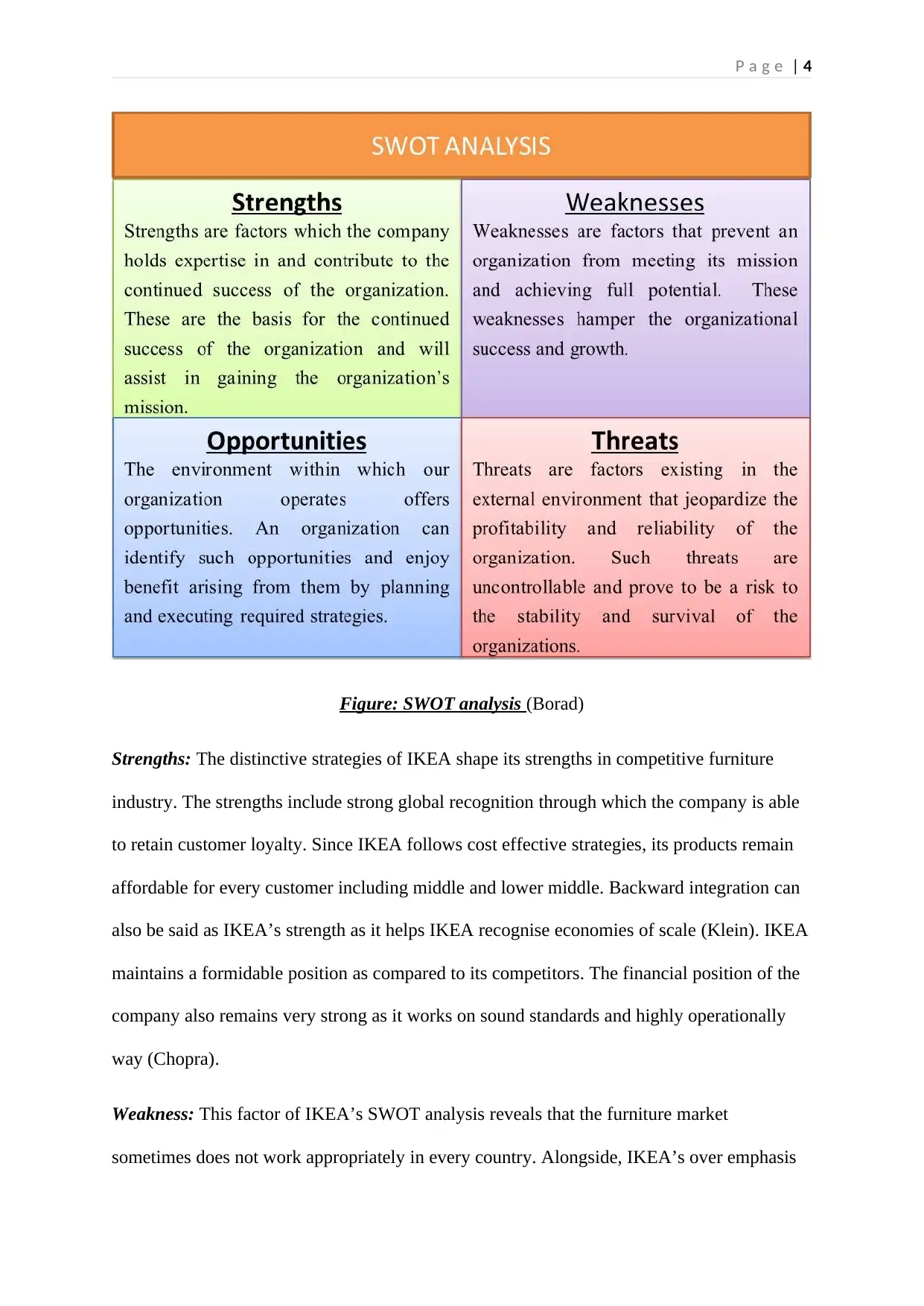
P a g e | 4
Figure: SWOT analysis (Borad)
Strengths: The distinctive strategies of IKEA shape its strengths in competitive furniture
industry. The strengths include strong global recognition through which the company is able
to retain customer loyalty. Since IKEA follows cost effective strategies, its products remain
affordable for every customer including middle and lower middle. Backward integration can
also be said as IKEA’s strength as it helps IKEA recognise economies of scale (Klein). IKEA
maintains a formidable position as compared to its competitors. The financial position of the
company also remains very strong as it works on sound standards and highly operationally
way (Chopra).
Weakness: This factor of IKEA’s SWOT analysis reveals that the furniture market
sometimes does not work appropriately in every country. Alongside, IKEA’s over emphasis
Figure: SWOT analysis (Borad)
Strengths: The distinctive strategies of IKEA shape its strengths in competitive furniture
industry. The strengths include strong global recognition through which the company is able
to retain customer loyalty. Since IKEA follows cost effective strategies, its products remain
affordable for every customer including middle and lower middle. Backward integration can
also be said as IKEA’s strength as it helps IKEA recognise economies of scale (Klein). IKEA
maintains a formidable position as compared to its competitors. The financial position of the
company also remains very strong as it works on sound standards and highly operationally
way (Chopra).
Weakness: This factor of IKEA’s SWOT analysis reveals that the furniture market
sometimes does not work appropriately in every country. Alongside, IKEA’s over emphasis
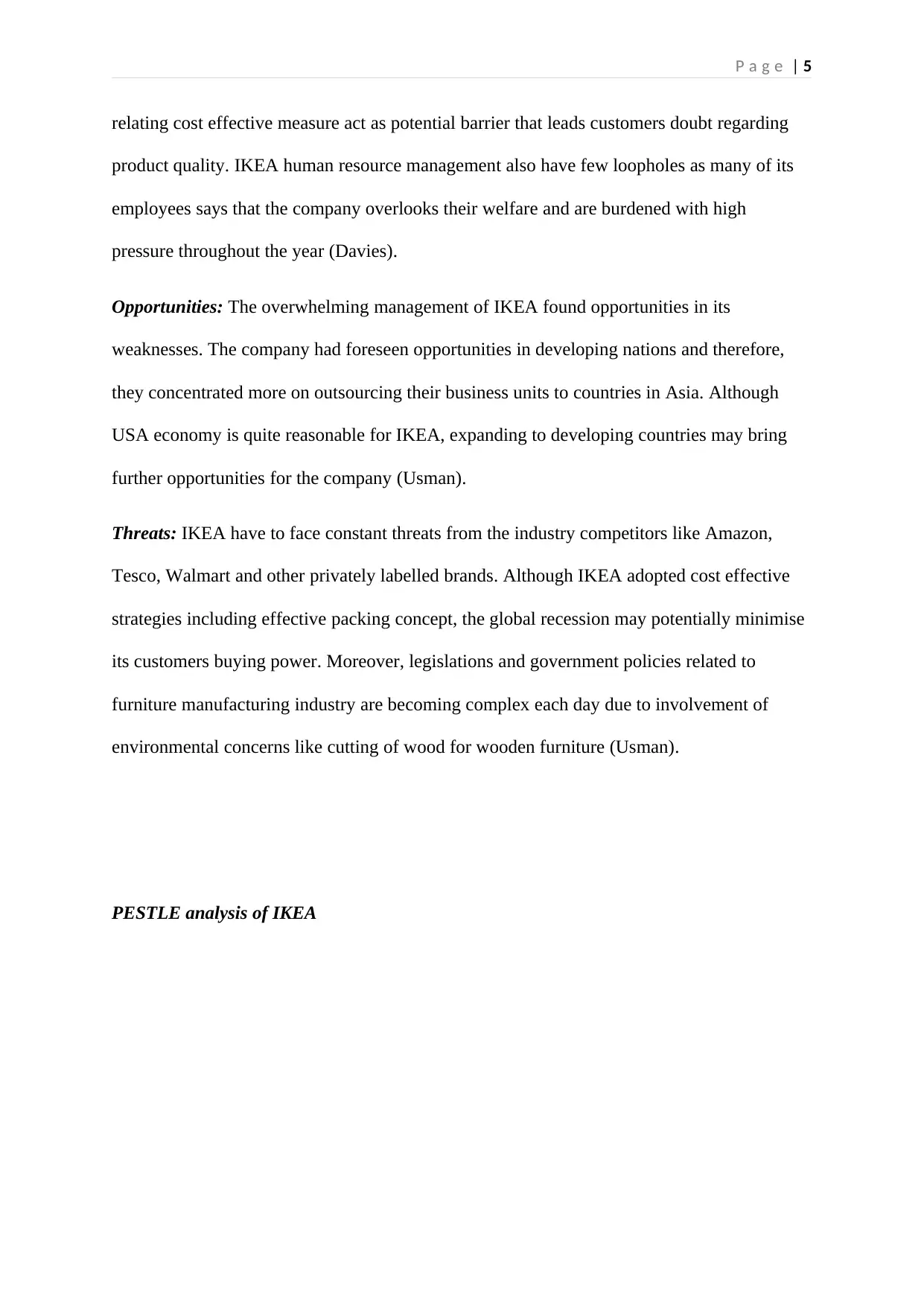
P a g e | 5
relating cost effective measure act as potential barrier that leads customers doubt regarding
product quality. IKEA human resource management also have few loopholes as many of its
employees says that the company overlooks their welfare and are burdened with high
pressure throughout the year (Davies).
Opportunities: The overwhelming management of IKEA found opportunities in its
weaknesses. The company had foreseen opportunities in developing nations and therefore,
they concentrated more on outsourcing their business units to countries in Asia. Although
USA economy is quite reasonable for IKEA, expanding to developing countries may bring
further opportunities for the company (Usman).
Threats: IKEA have to face constant threats from the industry competitors like Amazon,
Tesco, Walmart and other privately labelled brands. Although IKEA adopted cost effective
strategies including effective packing concept, the global recession may potentially minimise
its customers buying power. Moreover, legislations and government policies related to
furniture manufacturing industry are becoming complex each day due to involvement of
environmental concerns like cutting of wood for wooden furniture (Usman).
PESTLE analysis of IKEA
relating cost effective measure act as potential barrier that leads customers doubt regarding
product quality. IKEA human resource management also have few loopholes as many of its
employees says that the company overlooks their welfare and are burdened with high
pressure throughout the year (Davies).
Opportunities: The overwhelming management of IKEA found opportunities in its
weaknesses. The company had foreseen opportunities in developing nations and therefore,
they concentrated more on outsourcing their business units to countries in Asia. Although
USA economy is quite reasonable for IKEA, expanding to developing countries may bring
further opportunities for the company (Usman).
Threats: IKEA have to face constant threats from the industry competitors like Amazon,
Tesco, Walmart and other privately labelled brands. Although IKEA adopted cost effective
strategies including effective packing concept, the global recession may potentially minimise
its customers buying power. Moreover, legislations and government policies related to
furniture manufacturing industry are becoming complex each day due to involvement of
environmental concerns like cutting of wood for wooden furniture (Usman).
PESTLE analysis of IKEA
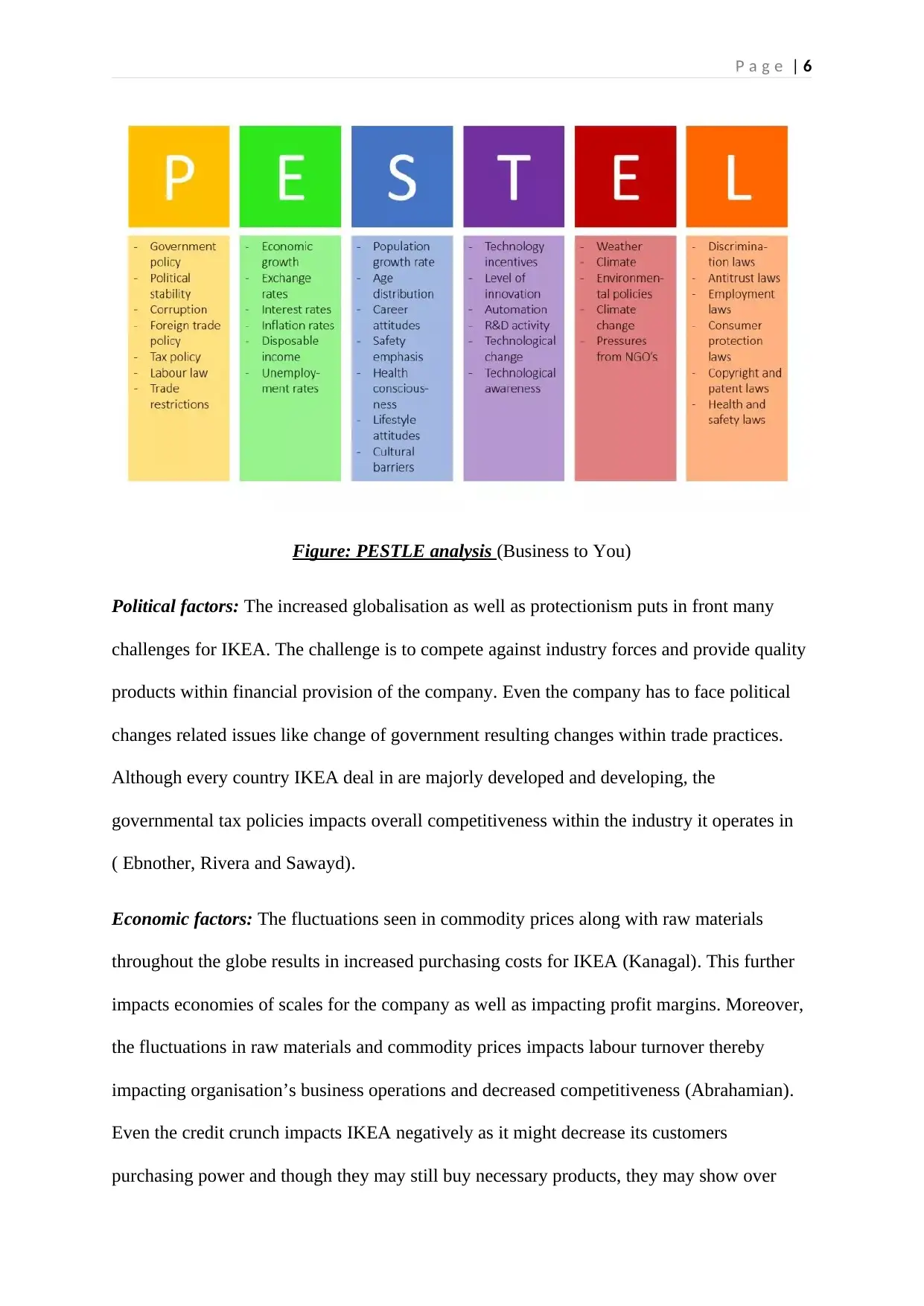
P a g e | 6
Figure: PESTLE analysis (Business to You)
Political factors: The increased globalisation as well as protectionism puts in front many
challenges for IKEA. The challenge is to compete against industry forces and provide quality
products within financial provision of the company. Even the company has to face political
changes related issues like change of government resulting changes within trade practices.
Although every country IKEA deal in are majorly developed and developing, the
governmental tax policies impacts overall competitiveness within the industry it operates in
( Ebnother, Rivera and Sawayd).
Economic factors: The fluctuations seen in commodity prices along with raw materials
throughout the globe results in increased purchasing costs for IKEA (Kanagal). This further
impacts economies of scales for the company as well as impacting profit margins. Moreover,
the fluctuations in raw materials and commodity prices impacts labour turnover thereby
impacting organisation’s business operations and decreased competitiveness (Abrahamian).
Even the credit crunch impacts IKEA negatively as it might decrease its customers
purchasing power and though they may still buy necessary products, they may show over
Figure: PESTLE analysis (Business to You)
Political factors: The increased globalisation as well as protectionism puts in front many
challenges for IKEA. The challenge is to compete against industry forces and provide quality
products within financial provision of the company. Even the company has to face political
changes related issues like change of government resulting changes within trade practices.
Although every country IKEA deal in are majorly developed and developing, the
governmental tax policies impacts overall competitiveness within the industry it operates in
( Ebnother, Rivera and Sawayd).
Economic factors: The fluctuations seen in commodity prices along with raw materials
throughout the globe results in increased purchasing costs for IKEA (Kanagal). This further
impacts economies of scales for the company as well as impacting profit margins. Moreover,
the fluctuations in raw materials and commodity prices impacts labour turnover thereby
impacting organisation’s business operations and decreased competitiveness (Abrahamian).
Even the credit crunch impacts IKEA negatively as it might decrease its customers
purchasing power and though they may still buy necessary products, they may show over
Paraphrase This Document
Need a fresh take? Get an instant paraphrase of this document with our AI Paraphraser
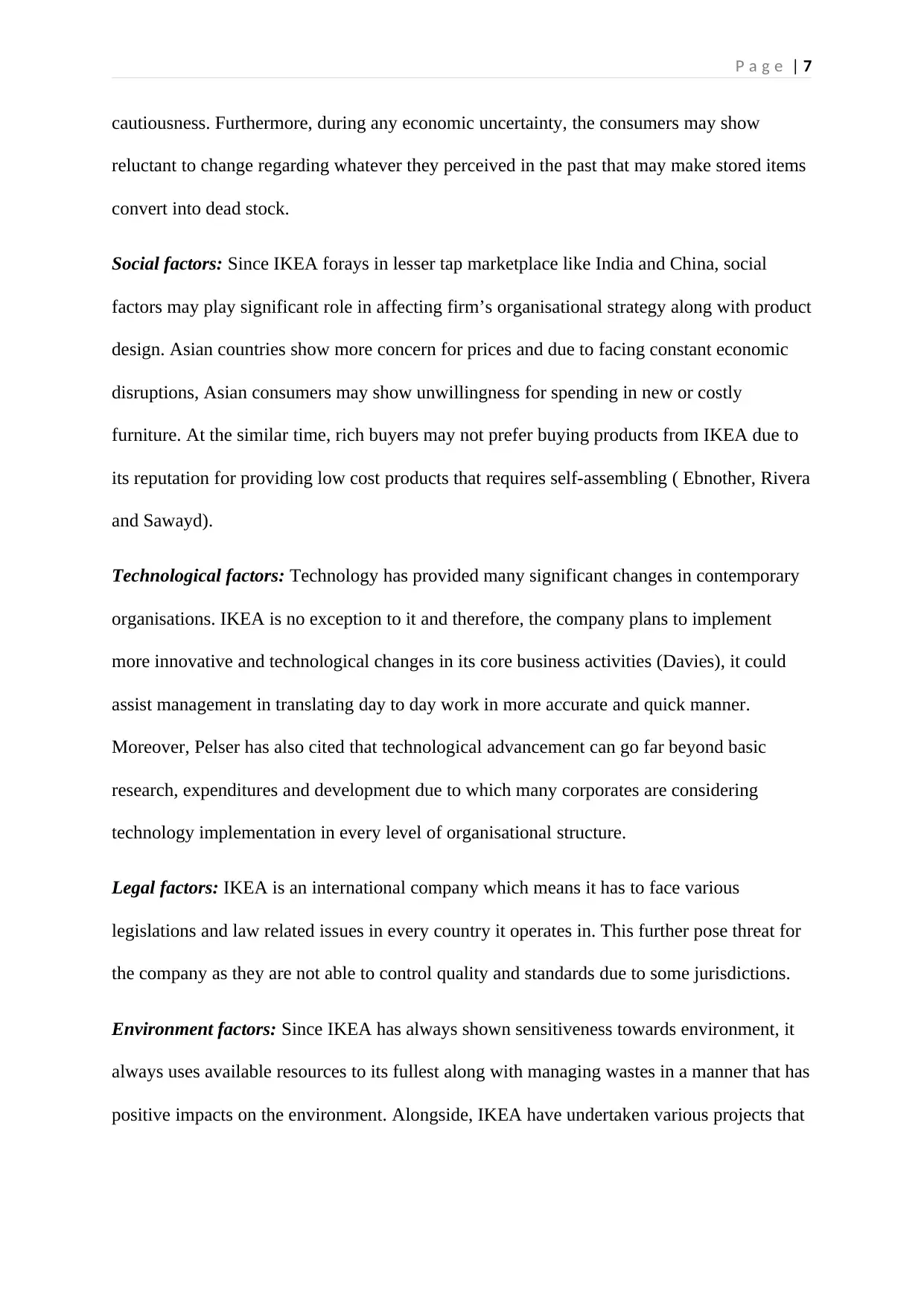
P a g e | 7
cautiousness. Furthermore, during any economic uncertainty, the consumers may show
reluctant to change regarding whatever they perceived in the past that may make stored items
convert into dead stock.
Social factors: Since IKEA forays in lesser tap marketplace like India and China, social
factors may play significant role in affecting firm’s organisational strategy along with product
design. Asian countries show more concern for prices and due to facing constant economic
disruptions, Asian consumers may show unwillingness for spending in new or costly
furniture. At the similar time, rich buyers may not prefer buying products from IKEA due to
its reputation for providing low cost products that requires self-assembling ( Ebnother, Rivera
and Sawayd).
Technological factors: Technology has provided many significant changes in contemporary
organisations. IKEA is no exception to it and therefore, the company plans to implement
more innovative and technological changes in its core business activities (Davies), it could
assist management in translating day to day work in more accurate and quick manner.
Moreover, Pelser has also cited that technological advancement can go far beyond basic
research, expenditures and development due to which many corporates are considering
technology implementation in every level of organisational structure.
Legal factors: IKEA is an international company which means it has to face various
legislations and law related issues in every country it operates in. This further pose threat for
the company as they are not able to control quality and standards due to some jurisdictions.
Environment factors: Since IKEA has always shown sensitiveness towards environment, it
always uses available resources to its fullest along with managing wastes in a manner that has
positive impacts on the environment. Alongside, IKEA have undertaken various projects that
cautiousness. Furthermore, during any economic uncertainty, the consumers may show
reluctant to change regarding whatever they perceived in the past that may make stored items
convert into dead stock.
Social factors: Since IKEA forays in lesser tap marketplace like India and China, social
factors may play significant role in affecting firm’s organisational strategy along with product
design. Asian countries show more concern for prices and due to facing constant economic
disruptions, Asian consumers may show unwillingness for spending in new or costly
furniture. At the similar time, rich buyers may not prefer buying products from IKEA due to
its reputation for providing low cost products that requires self-assembling ( Ebnother, Rivera
and Sawayd).
Technological factors: Technology has provided many significant changes in contemporary
organisations. IKEA is no exception to it and therefore, the company plans to implement
more innovative and technological changes in its core business activities (Davies), it could
assist management in translating day to day work in more accurate and quick manner.
Moreover, Pelser has also cited that technological advancement can go far beyond basic
research, expenditures and development due to which many corporates are considering
technology implementation in every level of organisational structure.
Legal factors: IKEA is an international company which means it has to face various
legislations and law related issues in every country it operates in. This further pose threat for
the company as they are not able to control quality and standards due to some jurisdictions.
Environment factors: Since IKEA has always shown sensitiveness towards environment, it
always uses available resources to its fullest along with managing wastes in a manner that has
positive impacts on the environment. Alongside, IKEA have undertaken various projects that
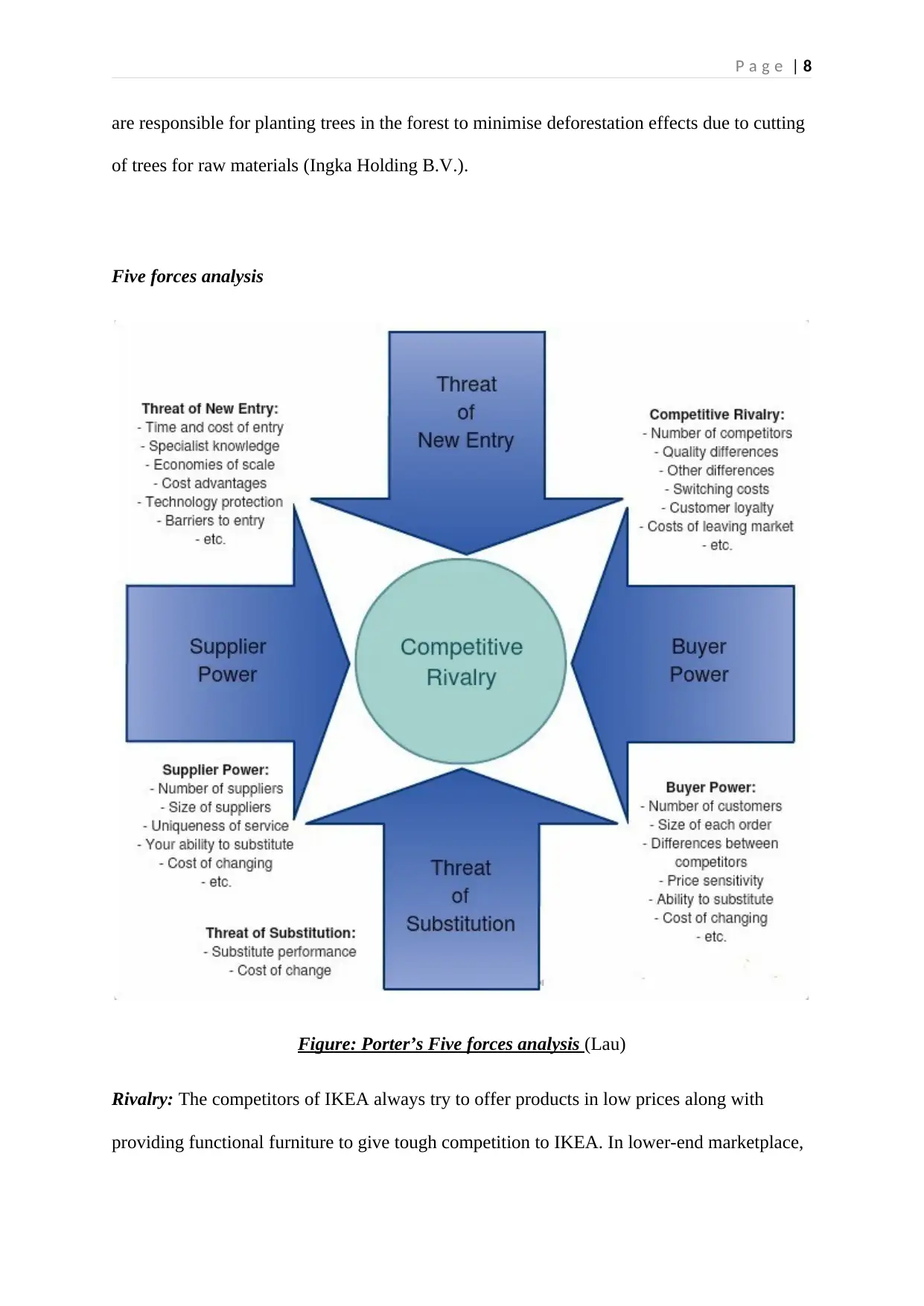
P a g e | 8
are responsible for planting trees in the forest to minimise deforestation effects due to cutting
of trees for raw materials (Ingka Holding B.V.).
Five forces analysis
Figure: Porter’s Five forces analysis (Lau)
Rivalry: The competitors of IKEA always try to offer products in low prices along with
providing functional furniture to give tough competition to IKEA. In lower-end marketplace,
are responsible for planting trees in the forest to minimise deforestation effects due to cutting
of trees for raw materials (Ingka Holding B.V.).
Five forces analysis
Figure: Porter’s Five forces analysis (Lau)
Rivalry: The competitors of IKEA always try to offer products in low prices along with
providing functional furniture to give tough competition to IKEA. In lower-end marketplace,
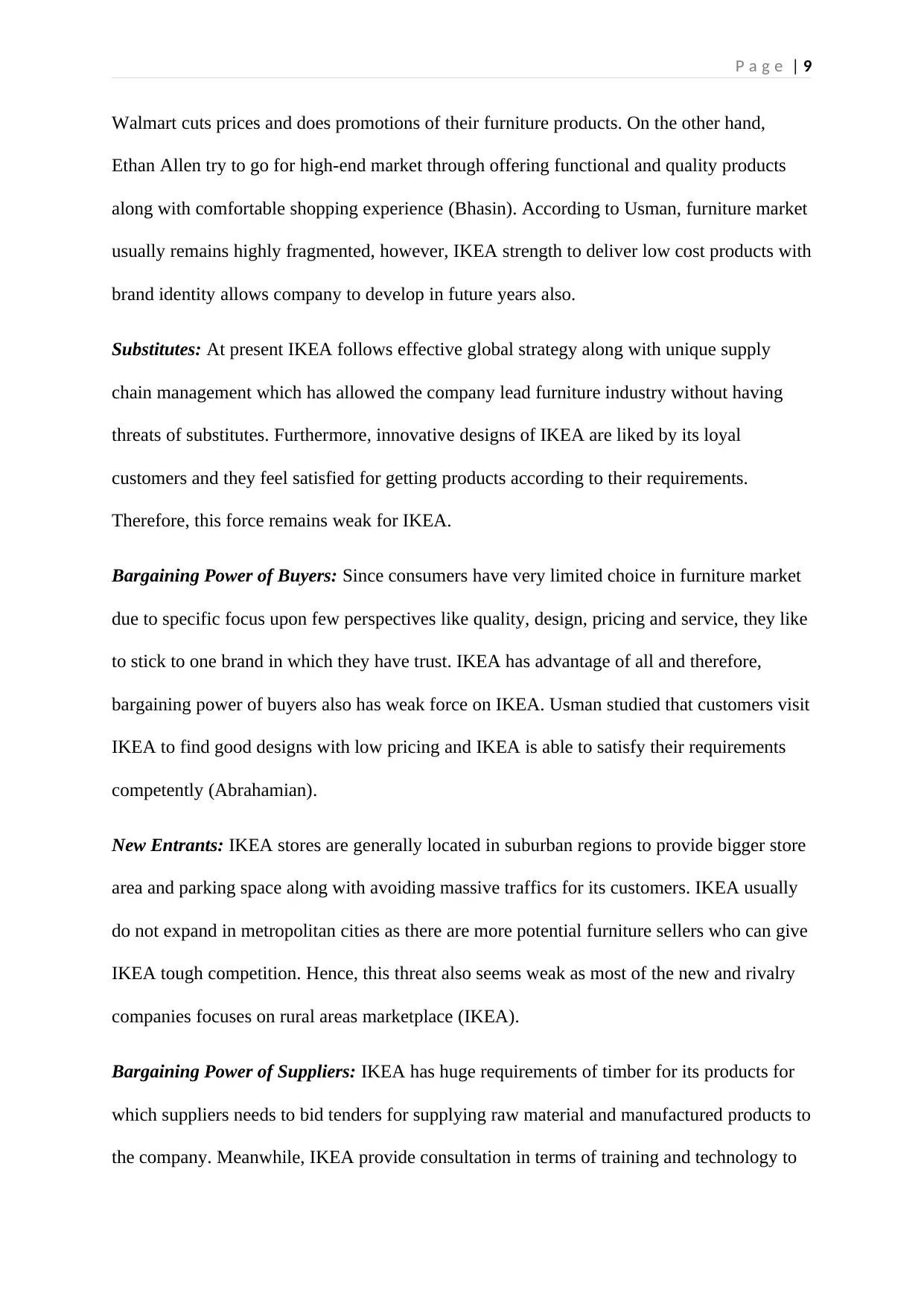
P a g e | 9
Walmart cuts prices and does promotions of their furniture products. On the other hand,
Ethan Allen try to go for high-end market through offering functional and quality products
along with comfortable shopping experience (Bhasin). According to Usman, furniture market
usually remains highly fragmented, however, IKEA strength to deliver low cost products with
brand identity allows company to develop in future years also.
Substitutes: At present IKEA follows effective global strategy along with unique supply
chain management which has allowed the company lead furniture industry without having
threats of substitutes. Furthermore, innovative designs of IKEA are liked by its loyal
customers and they feel satisfied for getting products according to their requirements.
Therefore, this force remains weak for IKEA.
Bargaining Power of Buyers: Since consumers have very limited choice in furniture market
due to specific focus upon few perspectives like quality, design, pricing and service, they like
to stick to one brand in which they have trust. IKEA has advantage of all and therefore,
bargaining power of buyers also has weak force on IKEA. Usman studied that customers visit
IKEA to find good designs with low pricing and IKEA is able to satisfy their requirements
competently (Abrahamian).
New Entrants: IKEA stores are generally located in suburban regions to provide bigger store
area and parking space along with avoiding massive traffics for its customers. IKEA usually
do not expand in metropolitan cities as there are more potential furniture sellers who can give
IKEA tough competition. Hence, this threat also seems weak as most of the new and rivalry
companies focuses on rural areas marketplace (IKEA).
Bargaining Power of Suppliers: IKEA has huge requirements of timber for its products for
which suppliers needs to bid tenders for supplying raw material and manufactured products to
the company. Meanwhile, IKEA provide consultation in terms of training and technology to
Walmart cuts prices and does promotions of their furniture products. On the other hand,
Ethan Allen try to go for high-end market through offering functional and quality products
along with comfortable shopping experience (Bhasin). According to Usman, furniture market
usually remains highly fragmented, however, IKEA strength to deliver low cost products with
brand identity allows company to develop in future years also.
Substitutes: At present IKEA follows effective global strategy along with unique supply
chain management which has allowed the company lead furniture industry without having
threats of substitutes. Furthermore, innovative designs of IKEA are liked by its loyal
customers and they feel satisfied for getting products according to their requirements.
Therefore, this force remains weak for IKEA.
Bargaining Power of Buyers: Since consumers have very limited choice in furniture market
due to specific focus upon few perspectives like quality, design, pricing and service, they like
to stick to one brand in which they have trust. IKEA has advantage of all and therefore,
bargaining power of buyers also has weak force on IKEA. Usman studied that customers visit
IKEA to find good designs with low pricing and IKEA is able to satisfy their requirements
competently (Abrahamian).
New Entrants: IKEA stores are generally located in suburban regions to provide bigger store
area and parking space along with avoiding massive traffics for its customers. IKEA usually
do not expand in metropolitan cities as there are more potential furniture sellers who can give
IKEA tough competition. Hence, this threat also seems weak as most of the new and rivalry
companies focuses on rural areas marketplace (IKEA).
Bargaining Power of Suppliers: IKEA has huge requirements of timber for its products for
which suppliers needs to bid tenders for supplying raw material and manufactured products to
the company. Meanwhile, IKEA provide consultation in terms of training and technology to
Secure Best Marks with AI Grader
Need help grading? Try our AI Grader for instant feedback on your assignments.
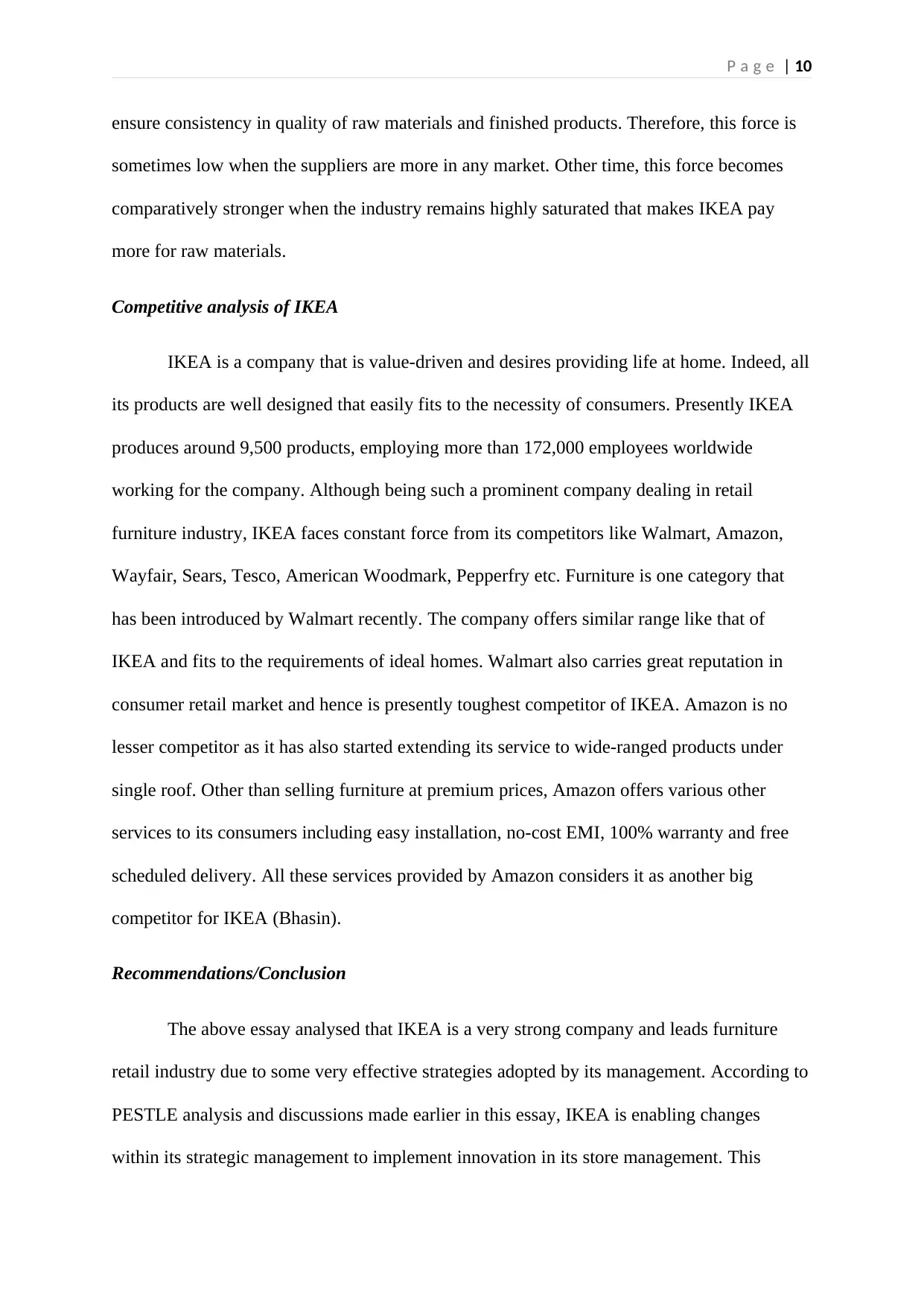
P a g e | 10
ensure consistency in quality of raw materials and finished products. Therefore, this force is
sometimes low when the suppliers are more in any market. Other time, this force becomes
comparatively stronger when the industry remains highly saturated that makes IKEA pay
more for raw materials.
Competitive analysis of IKEA
IKEA is a company that is value-driven and desires providing life at home. Indeed, all
its products are well designed that easily fits to the necessity of consumers. Presently IKEA
produces around 9,500 products, employing more than 172,000 employees worldwide
working for the company. Although being such a prominent company dealing in retail
furniture industry, IKEA faces constant force from its competitors like Walmart, Amazon,
Wayfair, Sears, Tesco, American Woodmark, Pepperfry etc. Furniture is one category that
has been introduced by Walmart recently. The company offers similar range like that of
IKEA and fits to the requirements of ideal homes. Walmart also carries great reputation in
consumer retail market and hence is presently toughest competitor of IKEA. Amazon is no
lesser competitor as it has also started extending its service to wide-ranged products under
single roof. Other than selling furniture at premium prices, Amazon offers various other
services to its consumers including easy installation, no-cost EMI, 100% warranty and free
scheduled delivery. All these services provided by Amazon considers it as another big
competitor for IKEA (Bhasin).
Recommendations/Conclusion
The above essay analysed that IKEA is a very strong company and leads furniture
retail industry due to some very effective strategies adopted by its management. According to
PESTLE analysis and discussions made earlier in this essay, IKEA is enabling changes
within its strategic management to implement innovation in its store management. This
ensure consistency in quality of raw materials and finished products. Therefore, this force is
sometimes low when the suppliers are more in any market. Other time, this force becomes
comparatively stronger when the industry remains highly saturated that makes IKEA pay
more for raw materials.
Competitive analysis of IKEA
IKEA is a company that is value-driven and desires providing life at home. Indeed, all
its products are well designed that easily fits to the necessity of consumers. Presently IKEA
produces around 9,500 products, employing more than 172,000 employees worldwide
working for the company. Although being such a prominent company dealing in retail
furniture industry, IKEA faces constant force from its competitors like Walmart, Amazon,
Wayfair, Sears, Tesco, American Woodmark, Pepperfry etc. Furniture is one category that
has been introduced by Walmart recently. The company offers similar range like that of
IKEA and fits to the requirements of ideal homes. Walmart also carries great reputation in
consumer retail market and hence is presently toughest competitor of IKEA. Amazon is no
lesser competitor as it has also started extending its service to wide-ranged products under
single roof. Other than selling furniture at premium prices, Amazon offers various other
services to its consumers including easy installation, no-cost EMI, 100% warranty and free
scheduled delivery. All these services provided by Amazon considers it as another big
competitor for IKEA (Bhasin).
Recommendations/Conclusion
The above essay analysed that IKEA is a very strong company and leads furniture
retail industry due to some very effective strategies adopted by its management. According to
PESTLE analysis and discussions made earlier in this essay, IKEA is enabling changes
within its strategic management to implement innovation in its store management. This
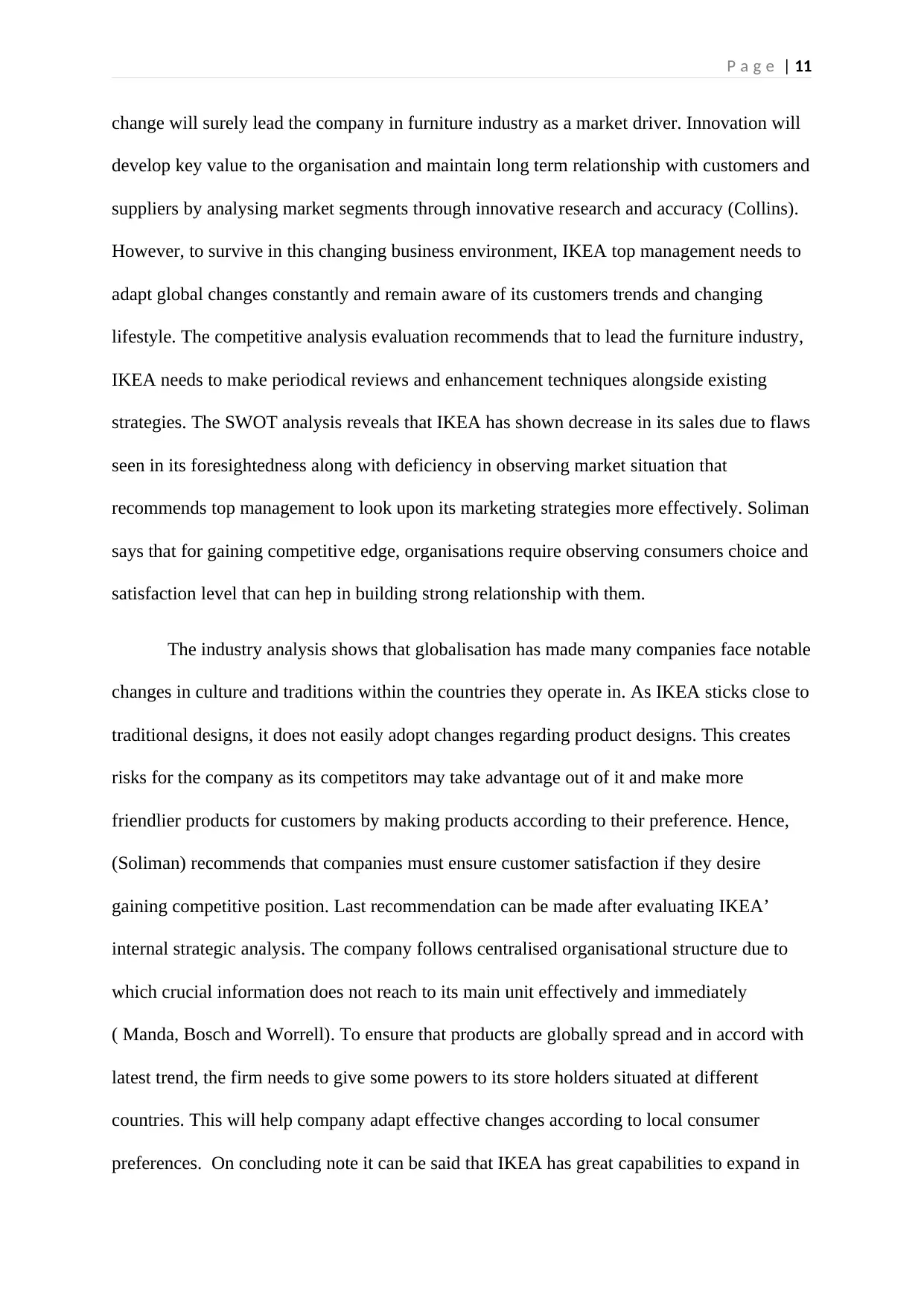
P a g e | 11
change will surely lead the company in furniture industry as a market driver. Innovation will
develop key value to the organisation and maintain long term relationship with customers and
suppliers by analysing market segments through innovative research and accuracy (Collins).
However, to survive in this changing business environment, IKEA top management needs to
adapt global changes constantly and remain aware of its customers trends and changing
lifestyle. The competitive analysis evaluation recommends that to lead the furniture industry,
IKEA needs to make periodical reviews and enhancement techniques alongside existing
strategies. The SWOT analysis reveals that IKEA has shown decrease in its sales due to flaws
seen in its foresightedness along with deficiency in observing market situation that
recommends top management to look upon its marketing strategies more effectively. Soliman
says that for gaining competitive edge, organisations require observing consumers choice and
satisfaction level that can hep in building strong relationship with them.
The industry analysis shows that globalisation has made many companies face notable
changes in culture and traditions within the countries they operate in. As IKEA sticks close to
traditional designs, it does not easily adopt changes regarding product designs. This creates
risks for the company as its competitors may take advantage out of it and make more
friendlier products for customers by making products according to their preference. Hence,
(Soliman) recommends that companies must ensure customer satisfaction if they desire
gaining competitive position. Last recommendation can be made after evaluating IKEA’
internal strategic analysis. The company follows centralised organisational structure due to
which crucial information does not reach to its main unit effectively and immediately
( Manda, Bosch and Worrell). To ensure that products are globally spread and in accord with
latest trend, the firm needs to give some powers to its store holders situated at different
countries. This will help company adapt effective changes according to local consumer
preferences. On concluding note it can be said that IKEA has great capabilities to expand in
change will surely lead the company in furniture industry as a market driver. Innovation will
develop key value to the organisation and maintain long term relationship with customers and
suppliers by analysing market segments through innovative research and accuracy (Collins).
However, to survive in this changing business environment, IKEA top management needs to
adapt global changes constantly and remain aware of its customers trends and changing
lifestyle. The competitive analysis evaluation recommends that to lead the furniture industry,
IKEA needs to make periodical reviews and enhancement techniques alongside existing
strategies. The SWOT analysis reveals that IKEA has shown decrease in its sales due to flaws
seen in its foresightedness along with deficiency in observing market situation that
recommends top management to look upon its marketing strategies more effectively. Soliman
says that for gaining competitive edge, organisations require observing consumers choice and
satisfaction level that can hep in building strong relationship with them.
The industry analysis shows that globalisation has made many companies face notable
changes in culture and traditions within the countries they operate in. As IKEA sticks close to
traditional designs, it does not easily adopt changes regarding product designs. This creates
risks for the company as its competitors may take advantage out of it and make more
friendlier products for customers by making products according to their preference. Hence,
(Soliman) recommends that companies must ensure customer satisfaction if they desire
gaining competitive position. Last recommendation can be made after evaluating IKEA’
internal strategic analysis. The company follows centralised organisational structure due to
which crucial information does not reach to its main unit effectively and immediately
( Manda, Bosch and Worrell). To ensure that products are globally spread and in accord with
latest trend, the firm needs to give some powers to its store holders situated at different
countries. This will help company adapt effective changes according to local consumer
preferences. On concluding note it can be said that IKEA has great capabilities to expand in
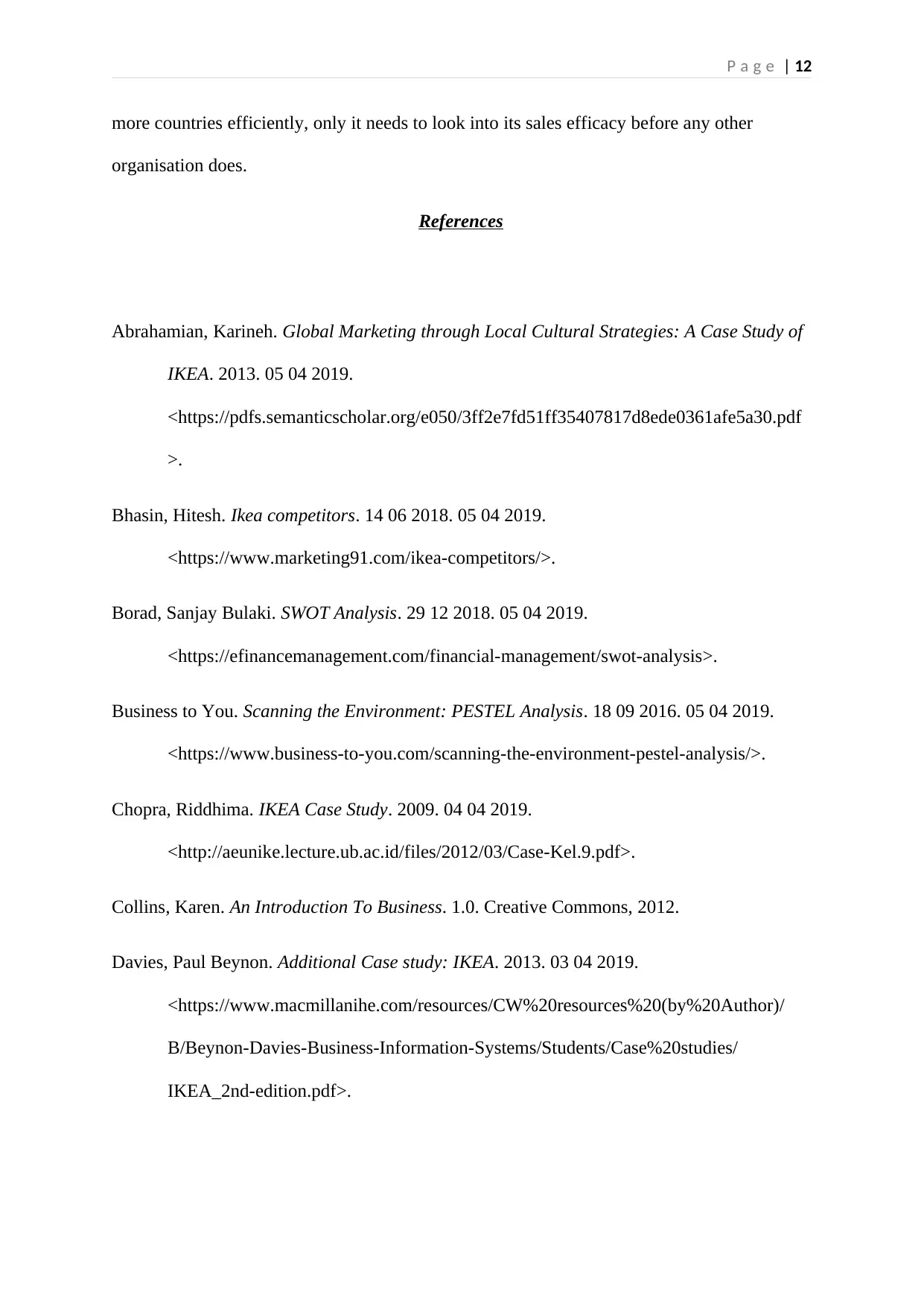
P a g e | 12
more countries efficiently, only it needs to look into its sales efficacy before any other
organisation does.
References
Abrahamian, Karineh. Global Marketing through Local Cultural Strategies: A Case Study of
IKEA. 2013. 05 04 2019.
<https://pdfs.semanticscholar.org/e050/3ff2e7fd51ff35407817d8ede0361afe5a30.pdf
>.
Bhasin, Hitesh. Ikea competitors. 14 06 2018. 05 04 2019.
<https://www.marketing91.com/ikea-competitors/>.
Borad, Sanjay Bulaki. SWOT Analysis. 29 12 2018. 05 04 2019.
<https://efinancemanagement.com/financial-management/swot-analysis>.
Business to You. Scanning the Environment: PESTEL Analysis. 18 09 2016. 05 04 2019.
<https://www.business-to-you.com/scanning-the-environment-pestel-analysis/>.
Chopra, Riddhima. IKEA Case Study. 2009. 04 04 2019.
<http://aeunike.lecture.ub.ac.id/files/2012/03/Case-Kel.9.pdf>.
Collins, Karen. An Introduction To Business. 1.0. Creative Commons, 2012.
Davies, Paul Beynon. Additional Case study: IKEA. 2013. 03 04 2019.
<https://www.macmillanihe.com/resources/CW%20resources%20(by%20Author)/
B/Beynon-Davies-Business-Information-Systems/Students/Case%20studies/
IKEA_2nd-edition.pdf>.
more countries efficiently, only it needs to look into its sales efficacy before any other
organisation does.
References
Abrahamian, Karineh. Global Marketing through Local Cultural Strategies: A Case Study of
IKEA. 2013. 05 04 2019.
<https://pdfs.semanticscholar.org/e050/3ff2e7fd51ff35407817d8ede0361afe5a30.pdf
>.
Bhasin, Hitesh. Ikea competitors. 14 06 2018. 05 04 2019.
<https://www.marketing91.com/ikea-competitors/>.
Borad, Sanjay Bulaki. SWOT Analysis. 29 12 2018. 05 04 2019.
<https://efinancemanagement.com/financial-management/swot-analysis>.
Business to You. Scanning the Environment: PESTEL Analysis. 18 09 2016. 05 04 2019.
<https://www.business-to-you.com/scanning-the-environment-pestel-analysis/>.
Chopra, Riddhima. IKEA Case Study. 2009. 04 04 2019.
<http://aeunike.lecture.ub.ac.id/files/2012/03/Case-Kel.9.pdf>.
Collins, Karen. An Introduction To Business. 1.0. Creative Commons, 2012.
Davies, Paul Beynon. Additional Case study: IKEA. 2013. 03 04 2019.
<https://www.macmillanihe.com/resources/CW%20resources%20(by%20Author)/
B/Beynon-Davies-Business-Information-Systems/Students/Case%20studies/
IKEA_2nd-edition.pdf>.
Paraphrase This Document
Need a fresh take? Get an instant paraphrase of this document with our AI Paraphraser
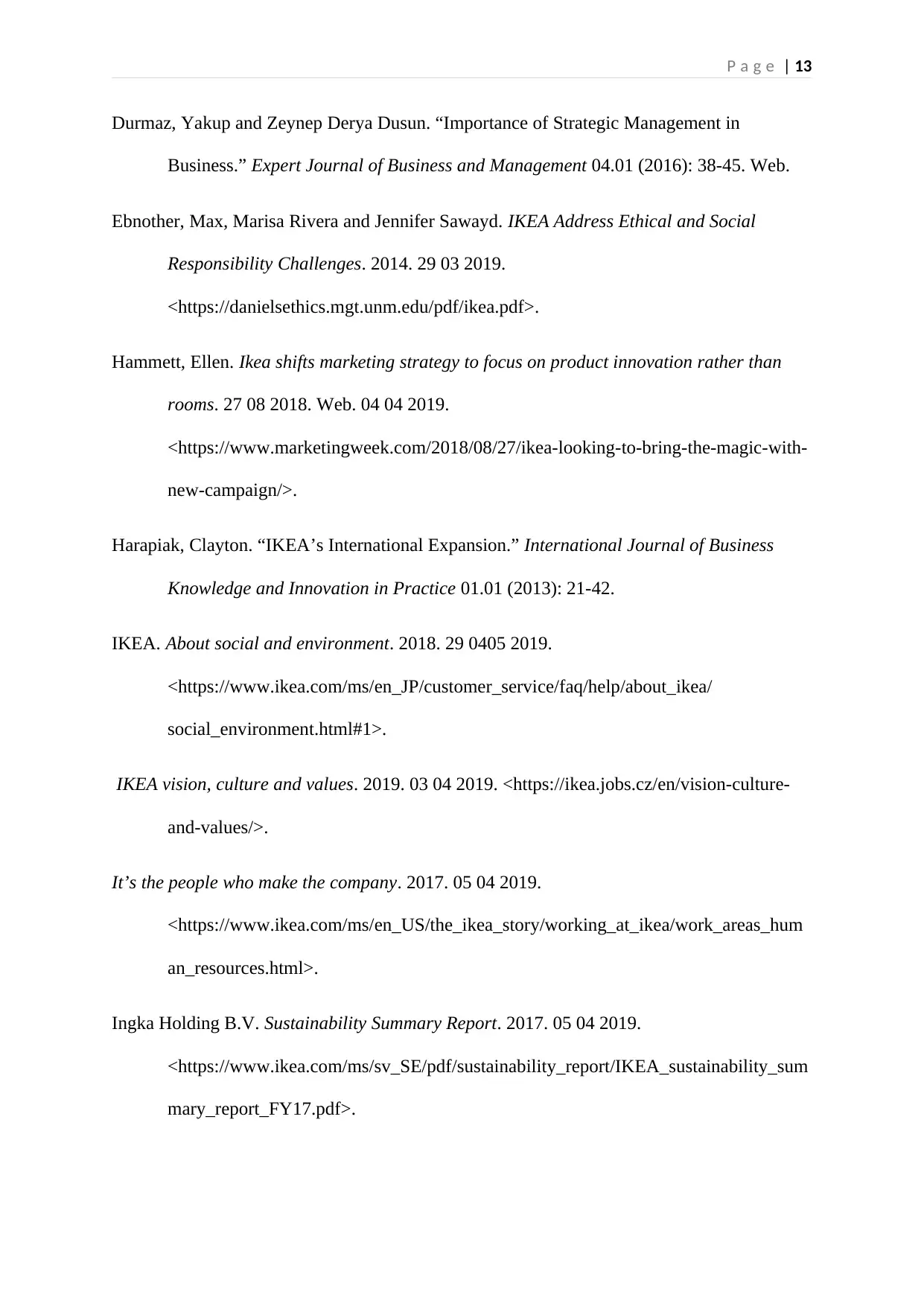
P a g e | 13
Durmaz, Yakup and Zeynep Derya Dusun. “Importance of Strategic Management in
Business.” Expert Journal of Business and Management 04.01 (2016): 38-45. Web.
Ebnother, Max, Marisa Rivera and Jennifer Sawayd. IKEA Address Ethical and Social
Responsibility Challenges. 2014. 29 03 2019.
<https://danielsethics.mgt.unm.edu/pdf/ikea.pdf>.
Hammett, Ellen. Ikea shifts marketing strategy to focus on product innovation rather than
rooms. 27 08 2018. Web. 04 04 2019.
<https://www.marketingweek.com/2018/08/27/ikea-looking-to-bring-the-magic-with-
new-campaign/>.
Harapiak, Clayton. “IKEA’s International Expansion.” International Journal of Business
Knowledge and Innovation in Practice 01.01 (2013): 21-42.
IKEA. About social and environment. 2018. 29 0405 2019.
<https://www.ikea.com/ms/en_JP/customer_service/faq/help/about_ikea/
social_environment.html#1>.
IKEA vision, culture and values. 2019. 03 04 2019. <https://ikea.jobs.cz/en/vision-culture-
and-values/>.
It’s the people who make the company. 2017. 05 04 2019.
<https://www.ikea.com/ms/en_US/the_ikea_story/working_at_ikea/work_areas_hum
an_resources.html>.
Ingka Holding B.V. Sustainability Summary Report. 2017. 05 04 2019.
<https://www.ikea.com/ms/sv_SE/pdf/sustainability_report/IKEA_sustainability_sum
mary_report_FY17.pdf>.
Durmaz, Yakup and Zeynep Derya Dusun. “Importance of Strategic Management in
Business.” Expert Journal of Business and Management 04.01 (2016): 38-45. Web.
Ebnother, Max, Marisa Rivera and Jennifer Sawayd. IKEA Address Ethical and Social
Responsibility Challenges. 2014. 29 03 2019.
<https://danielsethics.mgt.unm.edu/pdf/ikea.pdf>.
Hammett, Ellen. Ikea shifts marketing strategy to focus on product innovation rather than
rooms. 27 08 2018. Web. 04 04 2019.
<https://www.marketingweek.com/2018/08/27/ikea-looking-to-bring-the-magic-with-
new-campaign/>.
Harapiak, Clayton. “IKEA’s International Expansion.” International Journal of Business
Knowledge and Innovation in Practice 01.01 (2013): 21-42.
IKEA. About social and environment. 2018. 29 0405 2019.
<https://www.ikea.com/ms/en_JP/customer_service/faq/help/about_ikea/
social_environment.html#1>.
IKEA vision, culture and values. 2019. 03 04 2019. <https://ikea.jobs.cz/en/vision-culture-
and-values/>.
It’s the people who make the company. 2017. 05 04 2019.
<https://www.ikea.com/ms/en_US/the_ikea_story/working_at_ikea/work_areas_hum
an_resources.html>.
Ingka Holding B.V. Sustainability Summary Report. 2017. 05 04 2019.
<https://www.ikea.com/ms/sv_SE/pdf/sustainability_report/IKEA_sustainability_sum
mary_report_FY17.pdf>.
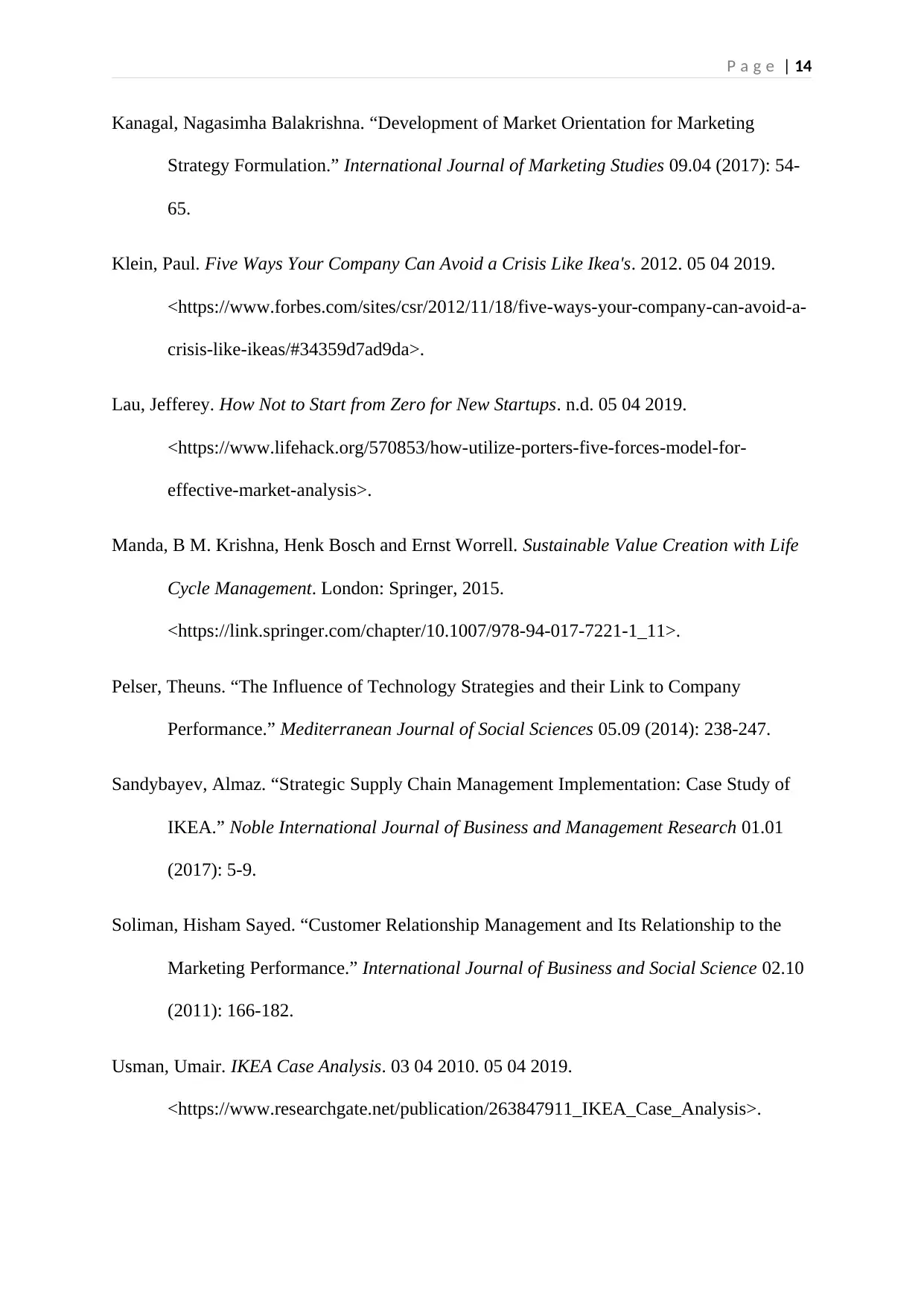
P a g e | 14
Kanagal, Nagasimha Balakrishna. “Development of Market Orientation for Marketing
Strategy Formulation.” International Journal of Marketing Studies 09.04 (2017): 54-
65.
Klein, Paul. Five Ways Your Company Can Avoid a Crisis Like Ikea's. 2012. 05 04 2019.
<https://www.forbes.com/sites/csr/2012/11/18/five-ways-your-company-can-avoid-a-
crisis-like-ikeas/#34359d7ad9da>.
Lau, Jefferey. How Not to Start from Zero for New Startups. n.d. 05 04 2019.
<https://www.lifehack.org/570853/how-utilize-porters-five-forces-model-for-
effective-market-analysis>.
Manda, B M. Krishna, Henk Bosch and Ernst Worrell. Sustainable Value Creation with Life
Cycle Management. London: Springer, 2015.
<https://link.springer.com/chapter/10.1007/978-94-017-7221-1_11>.
Pelser, Theuns. “The Influence of Technology Strategies and their Link to Company
Performance.” Mediterranean Journal of Social Sciences 05.09 (2014): 238-247.
Sandybayev, Almaz. “Strategic Supply Chain Management Implementation: Case Study of
IKEA.” Noble International Journal of Business and Management Research 01.01
(2017): 5-9.
Soliman, Hisham Sayed. “Customer Relationship Management and Its Relationship to the
Marketing Performance.” International Journal of Business and Social Science 02.10
(2011): 166-182.
Usman, Umair. IKEA Case Analysis. 03 04 2010. 05 04 2019.
<https://www.researchgate.net/publication/263847911_IKEA_Case_Analysis>.
Kanagal, Nagasimha Balakrishna. “Development of Market Orientation for Marketing
Strategy Formulation.” International Journal of Marketing Studies 09.04 (2017): 54-
65.
Klein, Paul. Five Ways Your Company Can Avoid a Crisis Like Ikea's. 2012. 05 04 2019.
<https://www.forbes.com/sites/csr/2012/11/18/five-ways-your-company-can-avoid-a-
crisis-like-ikeas/#34359d7ad9da>.
Lau, Jefferey. How Not to Start from Zero for New Startups. n.d. 05 04 2019.
<https://www.lifehack.org/570853/how-utilize-porters-five-forces-model-for-
effective-market-analysis>.
Manda, B M. Krishna, Henk Bosch and Ernst Worrell. Sustainable Value Creation with Life
Cycle Management. London: Springer, 2015.
<https://link.springer.com/chapter/10.1007/978-94-017-7221-1_11>.
Pelser, Theuns. “The Influence of Technology Strategies and their Link to Company
Performance.” Mediterranean Journal of Social Sciences 05.09 (2014): 238-247.
Sandybayev, Almaz. “Strategic Supply Chain Management Implementation: Case Study of
IKEA.” Noble International Journal of Business and Management Research 01.01
(2017): 5-9.
Soliman, Hisham Sayed. “Customer Relationship Management and Its Relationship to the
Marketing Performance.” International Journal of Business and Social Science 02.10
(2011): 166-182.
Usman, Umair. IKEA Case Analysis. 03 04 2010. 05 04 2019.
<https://www.researchgate.net/publication/263847911_IKEA_Case_Analysis>.

P a g e | 15
1 out of 16
Related Documents
Your All-in-One AI-Powered Toolkit for Academic Success.
+13062052269
info@desklib.com
Available 24*7 on WhatsApp / Email
![[object Object]](/_next/static/media/star-bottom.7253800d.svg)
Unlock your academic potential
© 2024 | Zucol Services PVT LTD | All rights reserved.





